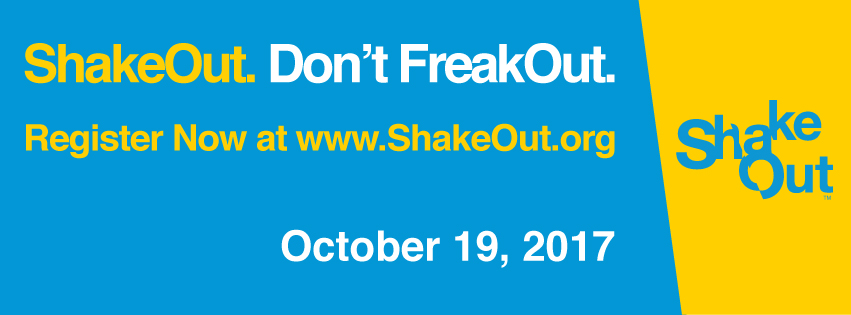- ▾ Other ShakeOuts ▾
- Alaska
- American Samoa
- Arizona
- British Columbia
- California
- Central U.S. (AL AR IA IL IN KS KY LA MO MS NE OH OK TN)
- CNMI
- Colorado
- Guam
- Hawaii
- Idaho
- Japan
- Montana
- Nevada
- New Mexico
- New Zealand
- NorthEast U.S. (CT MA ME NH NJ NY PA RI VT)
- Oregon
- Puerto Rico
- Quebec & Eastern Ontario
- SouthEast U.S. (DC DE FL GA MD NC SC VA WV)
- Texas
- Upper MidWest U.S. (MI MN ND SD WI)
- U.S. Virgin Islands
- Utah
- Washington State
- Wyoming
- Yukon
- Other Countries

Media Organizations
Media organizations (radio, TV, print, online) play a crucial role in informing people about Great ShakeOut Earthquake Drills. We consider you to be partners in helping the public prepare to survive and recover from the next damaging earthquake. Media organizations, reporters, writers, broadcasters and others are encouraged to get involved in several ways:
- Report on and help promote ShakeOut ahead of time and on International ShakeOut Day, this October 19. Story concepts, blurbs, PSAs, drill broadcasts, graphics, videos, and more are available at ShakeOut.org/messaging.
- Register your media organization to participate in ShakeOut. Make sure you too know how to protect yourself from earthquakes and ensure your workplace does too.
- See the sections below for print, radio, and tv media for more specific information.
ShakeOut Releases/Advisories
Last Year
10/13/2016: Millions Worldwide Participate In 2016 Great Shakeout Earthquake Drills
10/11/2016: Broadcasters Support Nationwide Participation in Great ShakeOut Earthquake Drills
Events / Contact
ShakeOut Media Venues:
Media Contact
Mark Benthien
Southern California Earthquake Center
Phone: (213) 926-1683
Website: https://www.scec.org
PRINT AND Online
Reporting about ShakeOut is a critical opportunity to help people get prepared for earthquakes. At ShakeOut.org/messaging, there are many pre-written blurbs, talking points, graphics, and videos to use in your story. Here are also a few ideas to help you along:
ShakeOut Information
The main page for gathering the latest count of how many are participating is the home page, ShakeOut.org. Please note:
- These counts are constantly changing as more people register or as people update their plans.
- These counts auto-update each night..
You can see who is participating by visiting shakeout.org/uppermidwest/whoisparticipating.
The Seven Steps to Earthquake Safety
We encourage ShakeOut participants to do more than practicing Drop, Cover, and Hold On. The Seven Steps to Earthquake Safety are a comprehensive guide for learning how to prepare to survive and recover from the next damaging earthquake, developed by a collaboration of emergency managers, communications experts, and scientists.
EarthquakeCountry.org/sevensteps
National Seismic Hazard Maps
The U.S. Geological Survey is responsible for publishing these maps which communicate the probability a certain level of ground shaking will occur in a 50-year timeframe. In fact, 1 in 2 Americans are at risk for ground shaking in the U.S.
earthquake.usgs.gov/hazards/products/
Social Science Research
ShakeOut has grown from a Southern California event to a worldwide movement in a matter of years, as when people see others taking action, they are more likely to take action, according to social science research.
Earthquake Insurance
Take-up of earthquake insurance policies is very low, even in seismically active areas, despite historical evidence of economic downturns following large earthquakes.
Those with a Disability or Access/Functional Need
Many people have some sort of need, whether that is related to mobility, cognizance, psychology or one of the five senses – while they too can learn how to prepare to survive and recover, Key Tips for People with Disabilities or other Access/Functional Needs is an essential guide:
EarthquakeCountry.org/disability
Examples
TIME | 20 Million Set to Take Part in ‘Great ShakeOut’ Earthquake Drill (2015)
The Gazette Democrat | Great ShakeOut earthquake drill planned on Oct. 20 (2016)
Radio Stations
Radio stations play a key role in ShakeOut participation in that many participants may choose to tune in to your station to use your ShakeOut drill broadcast to help guide their drill.
They may also hear about ShakeOut coming up on various radio stations too.
Here are a few resources to help accommodate your listeners:
- Fill out this brief form to be listed as a participating radio station that is playing the drill broadcast. Additionally, download the drill broadcasts, or scripts to make your own, ahead of time, at ShakeOut.org/messaging. (Click audio/video for the broadcast audio files, and messaging for scripts)
- Record a PSA (or play one of ours) for your listeners, promoting ShakeOut. Get scripts and links to download at ShakeOut.org/messaging. (Click audio/video for the broadcast audio files, and messaging for scripts.)
- Protect yourself and your organization! Make sure your stations also registers in ShakeOut and holds a Drop, Cover, and Hold On Drill
Examples
KPCC | ShakeOut: 6 steps to quake-proof your home
KQED | It’s ‘Earthquake Season’: Join California’s Great ShakeOut
TV Stations
Like radio stations, TV stations play a key role too in ShakeOut participation in that many participants may also choose to tune in to your station to hear a drill broadcast.
They may also hear about ShakeOut coming up on various tv stations too.
Here are a few resources to help accommodate your viewers:
- Fill out this brief form to be listed as a participating radio station that is playing the drill broadcast. Additionally, download the drill broadcasts, or scripts to make your own, ahead of time, at ShakeOut.org/messaging. (Click audio/video for the broadcast video files, and messaging for scripts)
- Record a PSA (or play one of ours) for your listeners, promoting ShakeOut. Get scripts and links to download at ShakeOut.org/messaging. (Click audio/video for the broadcast video files, and messaging for scripts.)
- Download B-roll from our Earthquake Safety Video Series to air in your stories, promotions, and drill broadcasts.
- Protect yourself and your organization! Make sure your stations also registers in ShakeOut and holds a Drop, Cover, and Hold On Drill
Examples
ABC7 (Bay Area) | Bay Area Life: How to prepare for the next big quake
ABC7 (SoCal) | Californians prepare for earthquake with annual Great ShakeOut drill



